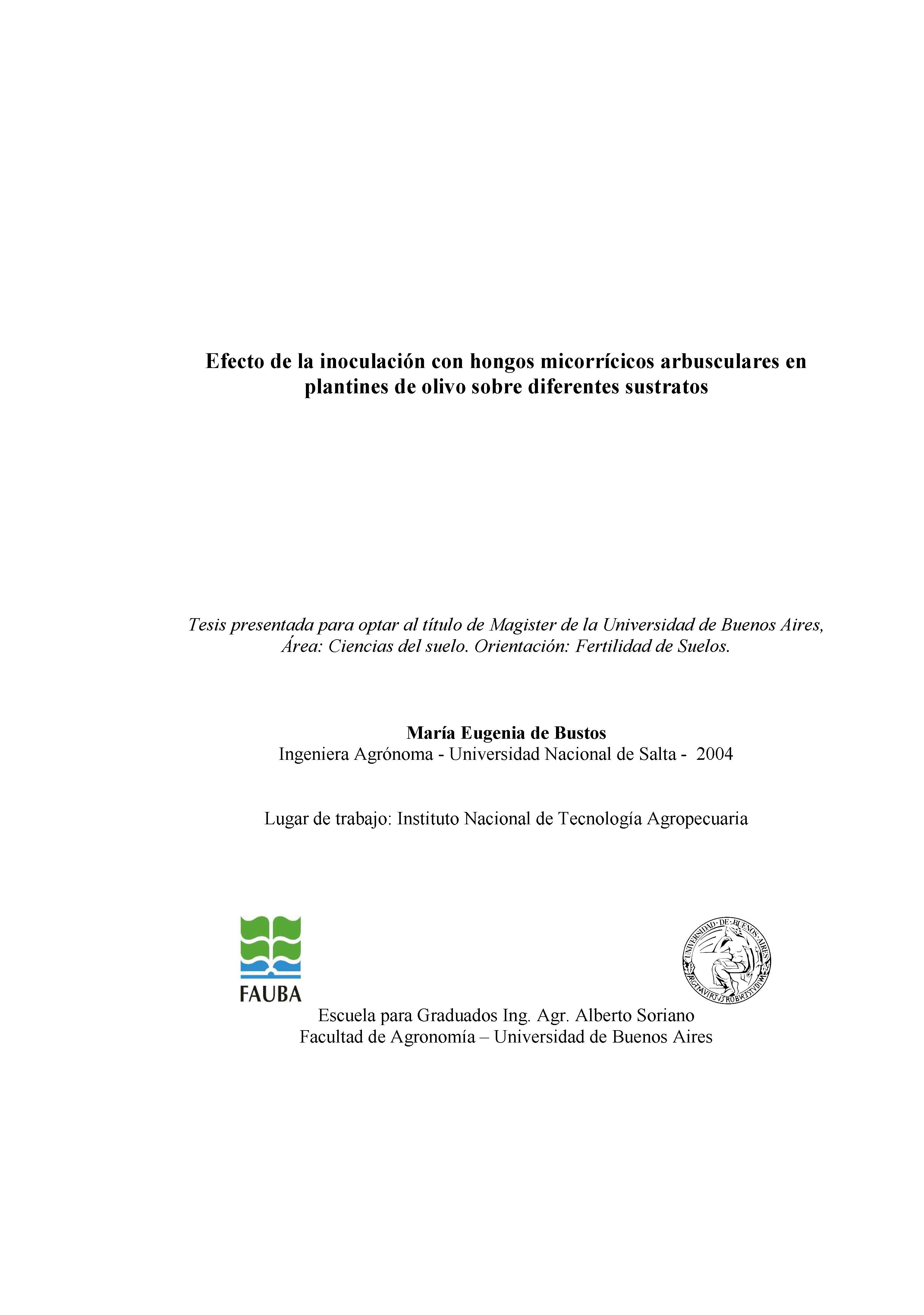Ver ítem
- xmlui.general.dspace_homeCentros Regionales y EEAsCentro Regional Catamarca - La RiojaEEA CatamarcaTesisxmlui.ArtifactBrowser.ItemViewer.trail
Efecto de la inoculación con hongos micorrícicos arbusculares en plantines de olivo sobre diferentes sustratos
Resumen
El olivo es un cultivo que se encuentra en fase de expansión, siendo Catamarca una de
las principales provincias productoras de Argentina. La meta de los viveros olivícolas es
obtener cantidad, calidad y rápido crecimiento de plantines de olivo con el menor costo.
El objetivo de este trabajo fue evaluar la mejor combinación hongo (cepa) - sustrato
(características) en la producción de plantines de olivo. Para ello, se seleccionaron
plantines en la
[ver mas...]
El olivo es un cultivo que se encuentra en fase de expansión, siendo Catamarca una de
las principales provincias productoras de Argentina. La meta de los viveros olivícolas es
obtener cantidad, calidad y rápido crecimiento de plantines de olivo con el menor costo.
El objetivo de este trabajo fue evaluar la mejor combinación hongo (cepa) - sustrato
(características) en la producción de plantines de olivo. Para ello, se seleccionaron
plantines en la etapa de endurecimiento, los cuales se colocaron en macetas con cuatro
sustratos diferentes: arena (SA), arena/turba (SB), arena/turba/suelo de monte (SC) y
suelo de monte (SD). Las plantas fueron inoculadas con dos cepas de micorrizas de la
especie Glomus intraradices. Las variables evaluadas fueron: supervivencia,
crecimiento, estado nutricional y porcentaje de colonización. Siendo el margen bruto la
principal variable económica analizada. Los resultados muestran que la inoculación con
HMA y las características de los sustratos no afectan la supervivencia de plantines de
olivo en etapa de cría, pero la inoculación influye positivamente en crecimiento y estado
nutricional. Sin embargo, el sustrato utilizado es el principal factor que determina el
tiempo de obtención de las plantas, ya que sus características físicas y químicas
condicionan las variables de crecimiento, nutrición y costos productivos. La madurez
fisiológica junto a la fertilidad química de los sustratos disminuyen la infectividad de
los HMA.
[Cerrar]
The olive is a crop that is being expanded all over the country and the province of
Catamarca is one of the largest producers of Argentina. In order to get quantity, quality
and improve growth in olive seedlings at the lowest cost. The aim of this study was to
evaluate the best combination of fungus (strain) - substrate (features) in the production
of olive seedlings.This experience used seedlings in the speedling stage, which were
placed in pots
[ver mas...]
The olive is a crop that is being expanded all over the country and the province of
Catamarca is one of the largest producers of Argentina. In order to get quantity, quality
and improve growth in olive seedlings at the lowest cost. The aim of this study was to
evaluate the best combination of fungus (strain) - substrate (features) in the production
of olive seedlings.This experience used seedlings in the speedling stage, which were
placed in pots filled with four different substrates: sand (SA), sand / peat (SB), sand /
peat / soil forest (SC) and floor mount (SD). Plants were inoculated with Glomus
intraradices strains GA and GB. The variables evaluated were: survival, growth,
nutritional status and rate of colonization. As the gross margin, the main economic
variable analyzed. The results show that inoculation with AMF and the characteristics
of the substrates do not affect the survival of seedlings of olive, but the inoculation
influenced positively the growth and nutritional status. However, the substrate is the
main factor that determines the time to obtain the plants, since their physical and
chemical variables make influence over the growth, nutrition and production costs.
Physiological maturity with the fertility of the substrates decrease the infectivity of the
HMA.
[Cerrar]

Director de Tesis
Fracchia, Sebastián (Consejero de Estudios);
Berbara, Ricardo L. (Consejero de Estudios);
Descripción
Tesis para obtener el grado de Magister Área: Ciencias del suelo. Orientación: Fertilidad de Suelos, presentada en la Facultad de Agronomía, Universidad de Buenos Aires el 16 de Febrero de 2012
Fecha
2012-02-16
Editorial
Escuela para Graduados Ing. Agr. Alberto Soriano, Facultad de Agronomía, Universidad de Buenos Aires
Formato
pdf
Tipo de documento
tesis de maestría
Palabras Claves
Derechos de acceso
Abierto
 Excepto donde se diga explicitamente, este item se publica bajo la siguiente descripción: Creative Commons Attribution-NonCommercial-ShareAlike 2.5 Unported (CC BY-NC-SA 2.5)
Excepto donde se diga explicitamente, este item se publica bajo la siguiente descripción: Creative Commons Attribution-NonCommercial-ShareAlike 2.5 Unported (CC BY-NC-SA 2.5)


